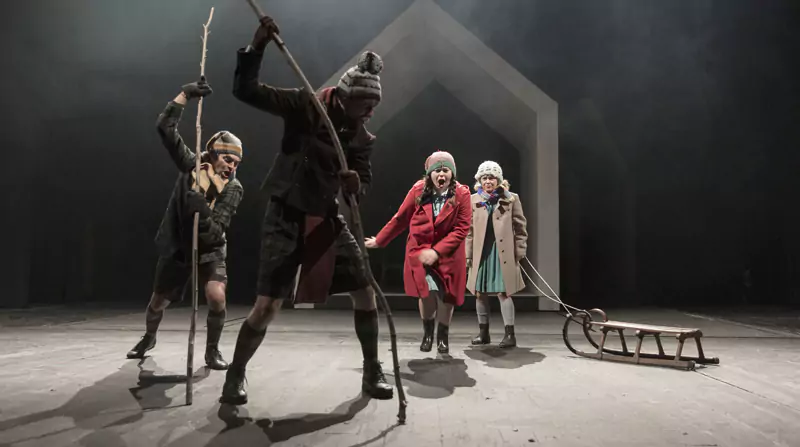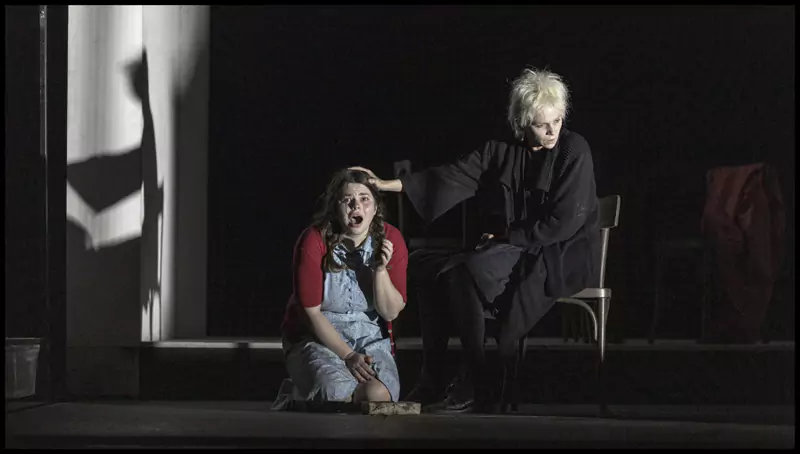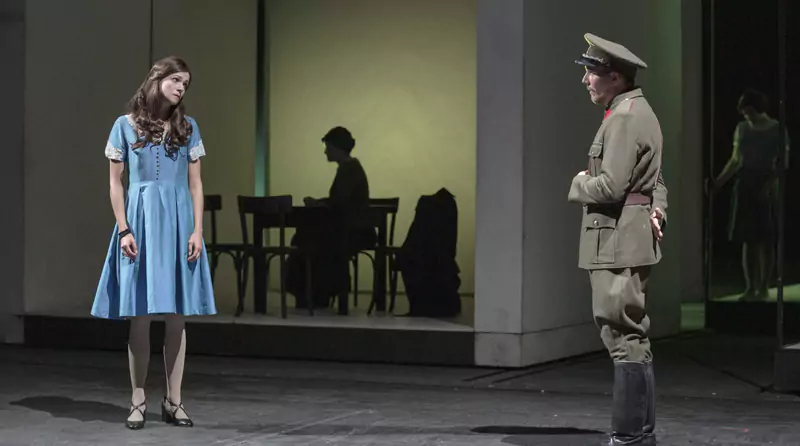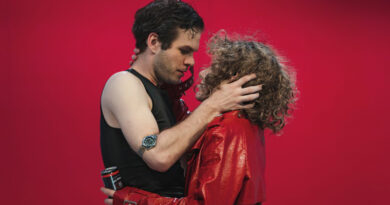“Hana” at Mahen Theatre, Brno
Dana Rufolo in the Czech Republic
8 September 2024
If This Is A Man by Primo Levi has always been the definitive literary text about the Holocaust, but Hana at the Mahen Theatre in Brno, Czech Republic, reminds us that there can never be too many works of literature devoted to looking back on how the Second World War altered individual destinies in tragic ways.

Photo credit: Patrick Boreký.
The 2017 novel with the same title by the Czech author Alena Mornštajnová describes the misfortunes of the Heler family in Valašské Meziříčí, a small Moravian town situated a mere 90-minute drive from Brno when nearly everyone in the family came down with typhoid fever in 1954 (a documented fact).
One nine-year-old child, Mira, survives, and she becomes instrumental in recounting her family history – what led up to that incident and what happens afterwards. Aunt Hana is central to this tale, and Mornštajnová found herself reaching back into the history of the Czech Jews in World War Two in order to flesh out her character. We gradually discover, as does Mira, that Hana is a concentration camp survivor. But because Mornštajnová created that back story to explain Hana’s behaviour around Mira, the bitterness that a genuine survivor might feel is mitigated. As a result, Hana the novel is a character-driven work that adapts perfectly to the dramatic medium.
Martin Glaser, who adapted and directed Hana, shows great respect for this award-winning novel which has been translated into over 20 languages. Glaser stages a linear sequence of events just as it is in Mornštajnová’s novel. There are no Regietheater style intrusions into the drama in the form of film and other media. The result is a production that is clear to follow – neither melodramatic nor exaggerated.
Ironically, Mira is spared illness because she had been disobedient and was being punished. Her mother Rosa (warm-hearted and maternal Kateřina Liďáková) forbids her to go near the river, but she and her friend Ivana disobey. Mira takes up the dare of the older boys there and jumps on an ice floe only to fall into the water. The boys with their long sticks, sporty shorts and thick socks, their loud voices and lack of eye contact with Mira and her friend, seem like trolls, mythical creatures taunting the girls. Deftly, they loom over them. And even more complicatedly, although they could not care less if they harm her, the boys end up protecting Mira. She skittles home, rocking from side to side in a coat that has frozen stiff on her, and Rosa – more from fear that her daughter might fall ill than from anger – refuses to offer Mira the sweet dessert that is contaminated with the bacterium that causes typhoid and kills everyone in the family except Mira and Hana, the survivor.
Already in this opening scene, the theme of the intractability of fate is on display. What makes Hana unique is that each intimate scene in the play supports the Weltanschauung that events have unpredictable outcomes. In what appears to be a good event, a bad consequence can be lurking. Or the opposite: what appears to be negative can have positive consequences. Everything that happens in Hana seems to be a series of accidents, and the accidents are the result of an uneasy interface between human intentions and fate.
When her parents and siblings die of typhoid, Mira (played in the drama with directness and honesty by the adult Elena Trčková) is liable to be sent to a state orphanage if no one in her town offers her a home.

Elena Trčková as Mira and Petra Lorenc as the older Hana.
Photo credit: Patrick Boreký.
Her only surviving relative is her weirdly taciturn and unkempt aunt Hana, a woman she fears, so instead Mira is taken in by her mother Rosa’s childhood friend Ivana Horáčková, who loves her as her own. Hana Briešťanská plays Ivana with conviction and determination; she absolutely intends to integrate Mira into her family, but in keeping with the theme of the play, she is up against the resentment of Ivana’s grouchy husband Jaroslav (Tomáš David) and the jealousy of her biological children who hate Mira, the daughter Ida even plotting to kill her. Ultimately Ivana cannot stand up for what is right, and the opposite of what she wants takes place. Jaroslav goes to see Hana behind Ivana’s back, and in no uncertain terms he tells her to fetch Mira immediately. So, whether she likes it or not, Mira ends up living with her reclusive and frightening aunt, Hana.
At this point in the play, neither Mira nor we the audience members know that Hana, played by Petra Lorenc, has a tragic past. She indeed appears to be as scary as Mira perceives her to be. Only gradually will she become illuminated by empathy, and Mira will grow to love her for who she is. The conversion is staged as a physical transformation. But for the time being, the Hana we see on stage is stiff and unattractive: a white-haired, enervated, withdrawn and taciturn creature.
In the second act of the stage play (which corresponds to the second and third parts of the novel: “Those who came before me, Mira” and “I, Hana”) Hana’s past is revealed: she is a survivor of a concentration camp.
Many narratives by survivors recount the agony of suffering from survivor guilt. Hana too is riddled with guilt feelings but less so because she survived the concentration camp than because she believes that her intentionally delaying her family’s departure to the UK resulted in the extermination of all her family with the exception of herself and her sister Rosa, who had been sequestered with friends back in Valašské Meziříčí when the others were deported to Terezín.
As I said earlier, we are learning about Hana’s past at the same time that Mira is learning about her. Mira wants to find out why her aunt behaves so strangely and in fact states at the beginning of the second act that she doesn’t understand why we tend to never ask about our family’s history when we are growing up. Lorenc now appears on stage as the pretty young woman Hana had been before she lost her teeth and her hair and her health and her new-born boy child and his father, and had turned into that rubbed-out figure Mira is so afraid of who obsessively chews on dry bread kept hidden in pockets of her worn clothing. Glaser’s directorial decision to acquaint us with the pretty, young Hana rather than with her gruesome older self significantly humanizes the character by showing how she made decisions in real time, when the future was not yet revealed. Again, this supports the theme that we cannot overcome fate. We can only live time forward, each decision we make causing repercussions that are impossible to imagine ahead of time.

Petra Lorenc as the young Hana and Tomáš David as Jaroslav.
Photo credit: Patrick Boreký.
Glaser’s decision to have Hana appear as her younger self for most of the play emphasizes that she is innocent. She is a victim of the pull of fate on hapless human beings, a pull which is intractable. Here, the staged version of Hana differs from its model. In the novel, she is merely absolved of the guilt she feels over having made poor decisions. The difference is subtle but worth mentioning. For example, when we read about Hana in the novel, we are acutely aware that her trust in her boyfriend (the same Jaroslav who will insist that Mira gets out of his home) is too naïve. Isn’t his sudden reluctance to marry her suspicious? Especially given that she ought to have heard rumours that soldiers were being instructed to avoid Jews? Delaying her family’s emigration to Britain by not mailing a request for a passport immediately when her mother has asked her to do means the family doesn’t escape, for by the time the final passport arrives, free movement of Jewish people has been stopped. Hana’s blind attachment to her fantasy hero Jaroslav leads directly to her family’s downfall.
But the play is more forward looking than the novel, and Hana’s possible mauvaise foi ever so slightly hinted at in Mornštajnová’s story never surfaces on stage. The director keeps the flow of events resolutely moving forward, as only can be done in theatre which depends on action. It is the happy end that is highlighted in this production: eventually Mira joyfully marries, and her aunt, valorized as a personality with her own integrity despite being odd, remains a vital part of her niece’s adulthood. Life continues.
And yet, the future is born from the past. While learning about Hana, Mira also learns about Rosa’s and Hana’s mother Elsa, the grandmother who did everything in her power to rob fate of its rapacious grip on her family. It is she who forced Hana to remain at Terezín while boarding a transport train to Auschwitz. And, yet again demonstrating the theme of Hana, it is because Hana – like everyone else in the concentration camp – doesn’t know the fate of her parents and fantasizes that they will return to fetch her someday, that she worms her way out of accompanying Polish children supposedly being transferred to Switzerland but in fact being brought to their death in a gas chamber, along with all the adult interred Jews ordered to accompany them, including Jarka, her best friend there (energetic Jana Štvrtecká) who teaches Hana how to survive but who falls for the ploy and so perishes. So, her longing to be reunited with her parents saves Hana’s life in one of those reversals of expectation with which the novel is replete.
Elsa is played by Tereza Groszmannová, the same actress who had the lead role in The Mother by Karel Čapek which I reviewed here. Again, she has the role of a determined woman who, being a widow, has taken on the entire responsibility for her family. She plays her role with stately elegance and passion.
Glaser’s Hana acquires resonance with a visually powerful set designed by Pavel Borák. The architectural centre-stage acting area of luminescent white material is shaped to resemble the outline of a house a five-year-old might draw: a peaked roof, two walls, a floor. The outline suggests a church as well, creating the metaphor that the family home – for it is within that space that the family scenes take place – is holy. Curiously, the historic Church of St. Trinity in the very Moravian town where the novel is set has a similar structure, a pyramidal roof its dominating feature. Rectangular stage spaces that are located on either side of the house are where scenes involving other town characters – friends, relations, business partners – take place.
In act two, when the family home has lost its quality as a sanctuary, double parallel structures resembling a side wall and a steeped roof that has been cut short, slide into place alongside the stage centre house shape. These are expandable extra spaces that will encompass the area of the concentration camp Hana is interned within and large group scenes. This entire acting area expands in breadth and also moves closer or further away from the audience.
This National Theater Brno production of Hana gives us the opportunity to experience the vitality of the characters directly. The greatest challenge for the director must have been keeping the small-town feel to the play, and he succeeds. The female characters’ naïveté is believable, and although the men bluster, we understand that they have little agency or power. Love and self-sacrifice are mitigating forces that modulate fate, but nonetheless all the characters without exception are caught in the dilemma of having to live life one step at a time without knowing, at the moment of choice, if they have chosen wisely. For better or for worse, there is no way out except forward.









